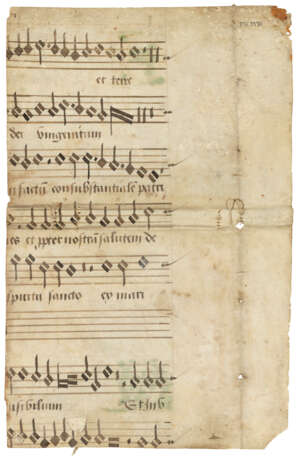ID 1053179
Lot 65 | Papal scribe Johannes Parvus
Estimate value
£ 6 000 – 9 000
A fragment from a Choirbook, in Latin, decorated manuscript on vellum [perhaps Flanders, mid-16th century, ?after c.1535]
A leaf from a Choirbook attributed to Johannes Parvus, principal scribe of polyphony for the Sistine Chapel from c.1535 to 1580.
A partial leaf, 306 x 197mm, ruled on both sides with eight 5-line staves. Verso with seven lines of polyphonic mensural notation and text written in black ink, the recto preserving six lines of notation, five lines of text and two decorated initials in pink and blue with white pen with foliate infill (recovered from a binding, preserving one tie and stitching holes, consequently worn and creased).
Provenance:
(1) Bloomsbury Auctions, 8 July 2016, lot 26.
(2) Schøyen Collection, MS 5581.
Text, script and music:
The text on the verso is from the Credo (‘[…]genitum non factu[m] consubstantiale[m] patri’); the recto text comes from the end of the Office of the Dead.
Mensural notation, in use from the end of the 13th century until the early 17th century, was the first system in European music to systematically use individual note shapes to denote duration: the evolution of the mensural – or ‘measured’ – system, with its highly complex rhythmic possibilities, marked a fundamental change in the writing of Western vocal polyphony (where plainchant, for the most part, retained the older system of neumes) and became the standard form of notation of Renaissance music.
The Schøyen catalogue records a tentative attribution for the fragment by Drs Margaret Bent and Jeffrey Dean to the Vatican scribe Johannes Parvus. Parvus primarily copied manuscripts for use in the Sistine Chapel, but may also have produced choirbooks for religious houses across Europe. The style of the two decorated initials suggests they were painted in 16th-century Flanders; evidence that grand choirbooks, of a scale similar to the parent manuscript from which our fragment must derive, in mensural notation were being produced in the Low Countries at this time comes in the form of a splendid manuscript painted in the court of Margaret of Austria now held in the Sistine Chapel (Capp. Sist. 160).
| Place of origin: | The Netherlands |
|---|---|
| Auction house category: | Medieval & renaissance manuscripts |
| Place of origin: | The Netherlands |
|---|---|
| Auction house category: | Medieval & renaissance manuscripts |
| Address of auction |
CHRISTIE'S 8 King Street, St. James's SW1Y 6QT London United Kingdom | ||||||
|---|---|---|---|---|---|---|---|
| Preview |
| ||||||
| Phone | +44 (0)20 7839 9060 | ||||||
| Buyer Premium | see on Website | ||||||
| Conditions of purchase | Conditions of purchase |




